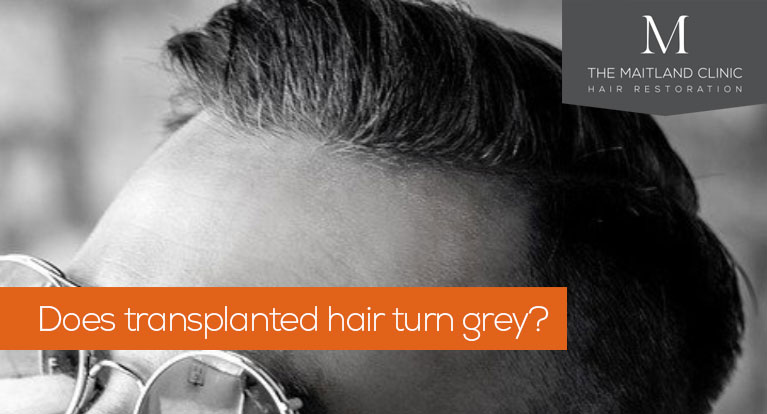Does transplanted hair turn grey?
29th October 2020

When planning a hair transplant, many of our patients are keen to know what their newly transplanted hair will look like. At The Maitland Clinic, we’re often asked questions such as “does transplanted hair turn grey?” Our team will be happy to talk through such issues with you in more detail, but this post provides an overview of the facts.
So, does transplanted hair turn grey? Whether transplanted hair turns grey will depend on the individual patient and the characteristics of their donor hair. Transplanted hairs behave in the same way as your natural hair. Therefore, if the hairs in the donor area turn grey then your transplanted hair will eventually become grey too.
Why does hair turn grey?
Hair colour is determined by a type of pigment known as melanin. Our genetic makeup dictates the quantity of melanin in our hair follicles and, consequently, the colour of our hair.
Although some people have naturally grey hair, for most of us the greying process starts as we get older. This is because melanin production slows or stops completely with advancing age. As the pigment cells begin to die and less melanin is made, the hair shafts start to lose their colour and eventually turn grey or white.
Hair can turn grey at any age. For some people, the process starts in their early twenties, while others might not spot their first grey hair until their forties. Genetics primarily determine when hair will begin to lose its colour, but diet and lifestyle can also play a role.
Does transplanted hair turn grey?
Before we consider this question in more detail and whether your hair transplant will turn grey, it’s important to understand how the hair transplant process works.
There are two main surgical methods for transplanting hair – these are known as Follicular Unit Transplantation (FUT or Strip) and Follicular Unit Excision/Extraction (FUE). Both techniques involve taking healthy hair follicles from an area of the head where the hair is genetically programmed to grow for life. This is known as the donor site and is usually located at the back of the patient’s scalp. The hair grafts are then carefully placed into tiny incisions in the balding areas of the scalp (the recipient area) to create a natural look that blends seamlessly with the native hair.
It’s important to understand that transplanted hair is not immune to the ageing process. Because a hair transplant takes the form of a transfer, the hairs moved to the recipient area continue to share the same genetic makeup and characteristics as the hairs in the donor area. So if, or when, melanin production in the donor area deteriorates and the hair turns grey, the transplanted hairs will eventually lose their colour too.
Can you transplant grey hair?
It’s a common misconception that grey hair is no longer healthy. Hair that is turning or has already turned grey can be just as strong as pigmented hair. This means it is possible to transplant grey hair just as successfully as hair of any other colour. In fact, the majority of the patients we see at The Maitland Clinic are in their thirties and above, when some natural greying has already started to take place.
You can see some of the results in our online gallery.
Can a hair transplant remove grey hair?
A hair transplant cannot change the colour of your existing hair as this is pre-determined by genetics. In this respect, the procedure cannot get rid of grey hair. If the donor hair is already grey or is starting to turn grey, the transplanted hair will also be grey. Very occasionally, hair restoration surgery can stimulate the premature greying of a transplanted hair but this does not affect the health or lifespan of that hair.
Creating a natural look
The Maitland Clinic’s leading surgeon, Dr Edward Ball, has a wealth of experience in performing hair transplants on grey hair and is renowned for his artistic flair and attention to detail. He considers a range of factors when planning a hair transplant, including the colour and characteristics of the patient’s hair, their facial shape, age and the growth pattern of the existing hair. He also takes great care over the angle, density and positioning of the grafts during the surgical process to create a bespoke, natural look that’s perfect for you.
Following your surgery, we encourage you to stay in touch with us for ongoing support and help to monitor the progress of your new hair growth. You’re welcome to return to us at any point, giving you access to a lifetime of professional hair care.
You can read more about our exceptional aftercare service here.
To find out more about hair transplants at The Maitland Clinic, or to book a consultation, please call us on 02392 706 122.










